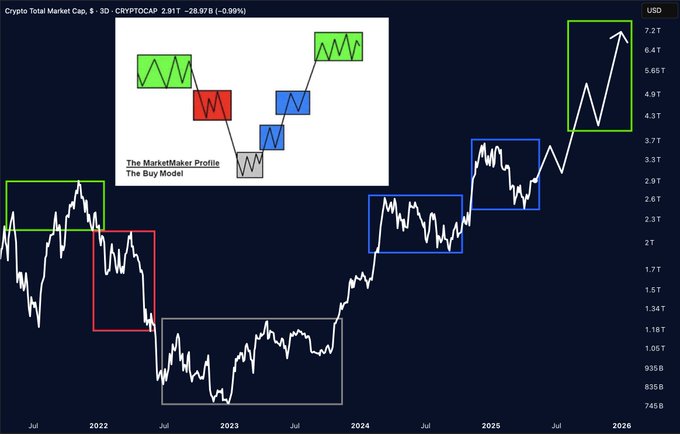Bitcoin at risk after losing $95K support; WAL jumps 10% amid broader slowdown
After failing to break past the $98,000 resistance level, Bitcoin retreated to key support levels from last month as market sentiment turned sour ahead of the US Federal Reserve’s interest rate decision later this week.
Crypto Fear and Greed Index, a key market sentiment gauge, fell 10 points to 52, shifting back to neutral after spending a week in greed territory.
The total cryptocurrency market cap was down roughly 3% when writing, hovering right above the $3 trillion mark.
Altcoins reflected the broader market slowdown, with only a few top tokens posting modest gains while most traded in the red.
Will Bitcoin go up?
Bitcoin bulls attempted to reclaim the $98K level over the weekend, but a lack of positive catalysts and growing stagflation concerns in the US economy pushed the price below the critical $95K support, a level it had struggled to break through during the final weeks of April.
On Wednesday, all eyes will be on the US Federal Reserve as it delivers its latest interest rate decision.
While markets widely expect the Fed to hold rates steady at 5.25%–5.50%, the spotlight is on Jerome Powell’s post-meeting remarks.
Traders are watching closely for any hint of a timeline on rate cuts, especially with inflation still hovering above the Fed’s 2% target.
Right now, Bitcoin is feeling the weight of macro uncertainty. The price has dropped nearly 5% from last week’s highs after failing to hold the $95K level.
Stagflation worries, marked by slowing growth and sticky inflation, have dampened risk appetite across markets. Unless Powell strikes a more dovish tone or data points to cooling inflation, BTC will likely struggle to regain momentum in the short term.
With Bitcoin having lost the key $95K support level, analysts are starting to flag the risk of a deeper pullback, especially if any fresh macro shock hits the market.
According to full-time trader and market analyst Paxton, a sharp move lower could take BTC towards the $84K–$76K zone, with key fib levels lining up as potential support.

Source: Paxton on X
Inflows into spot Bitcoin ETFs in the US have also slowed, adding to the current lack of momentum.
Total inflows last week dropped nearly 40% from the $3 billion-plus recorded the week before, highlighting a similar cautious stance from institutional investors as they await clarity from the Fed.
According to on-chain data from Glassnode, Bitcoin’s push into the $93K–$96K range triggered a spike in profit-taking activity, with the Realized Profit/Loss ratio showing that for every dollar sold at a loss, over $9 was sold at a profit.
This sharp imbalance points to significant sell-side pressure, often observed near local market tops.
Glassnode’s CryptoVizArt noted that profit-taking has now exceeded statistical norms, which typically signals a cooling-off phase.
Despite that, BTC is still holding above $93K, something he called “surprising” and “risky,” given how much profit is being locked in by short-term holders.
Several analysts pointed to $95,000 as the first key level Bitcoin must reclaim to regain bullish momentum.
A daily close above it would strengthen the case for another run at $98,000, currently the key resistance zone stopping the flagship crypto’s return to six figures.
On the downside, a failure to reclaim $95K could embolden bears to push BTC towards $91K.
According to analyst Carl Moon, Bitcoin has broken down from a rising wedge pattern, a bearish signal that suggests momentum is fading.
If Bitcoin hovers near that level, it would fill a CME gap sitting around $91.9K, as noted by analyst Hardy.
Historically, CME gaps tend to attract price action, and filling this lower gap could serve as a short-term target for bears looking to complete the move.
Should this level hold as support, Bitcoin may see a brief bounce, possibly retesting the $94K–$95K zone.
On the flip side, there’s also an upper CME gap at $97.3K, which remains in play if bulls regain momentum.
A strong move above $95K could set up a run to close this upper gap, strengthening the case for a renewed attempt at breaching the $98K resistance.
When writing, Bitcoin was down 1.8% in the past 24 hours at $93,955.
Altcoin market recap
Over the last 24 hours, the altcoin market cap rose 1.7% to $1.17 trillion, with the Altcoin Season Index at a reading of 23.
The low index value reflected the lack of risk appetite across the market, largely driven by Bitcoin’s poor performance and its break past key support levels.
Ethereum (ETH), the largest altcoin by market cap, had fallen 1.3% over the past day, returning back to the $1.8k level while other large-cap altcoins like XRP (XRP), Solana (SOL), Dogecoin (DOGE) and Cardano (ADA) experienced losses ranging from 1-4%.
Walrus (WAL) led the top 100 cryptocurrencies by market cap with double-digit gains of over 10% on the day, while Core (CORE) and Four (FOUR) followed with 9.2% and 9% respectively. See below:

Source: CoinMarketCap
Nevertheless, some analysts remained hopeful that an altcoin rally could begin soon.
According to Merlkin, the Trader who pointed to the total crypto market cap, “smart money has a position.
Market makers are about to unleash the final move.” (See below.)
MARKET MAKER PROFILE CONFIRMED ON TOTAL CRYPTO MARKET CAP!
Smart money has positioned.
Market makers are about to unleash the final move.
ALTCOINS ARE PRIMED FOR AN INSANE PARABOLIC SURGE!
However, prominent analyst Michaël van de Poppe thinks not every altcoin will rise even if an altcoin season kicks off.
“I think that we’ll see selective runs, and that’s why it’s the best strategy to go for blue chips,” said Poppe.
The post Bitcoin at risk after losing $95K support; WAL jumps 10% amid broader slowdown appeared first on Invezz

